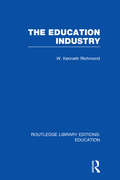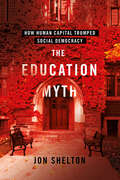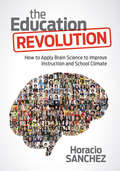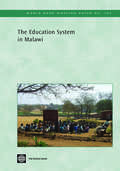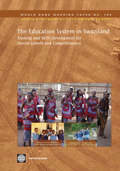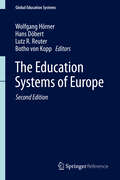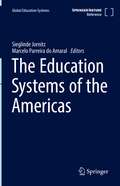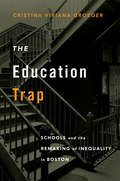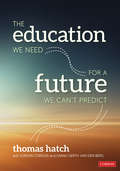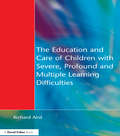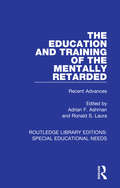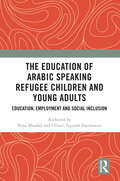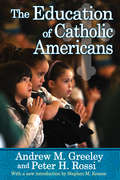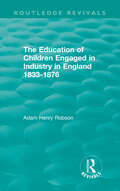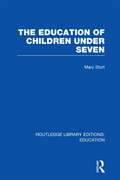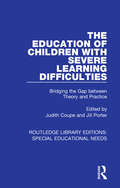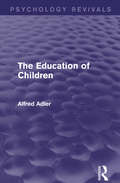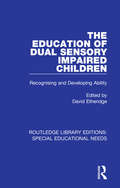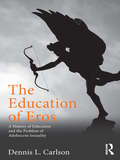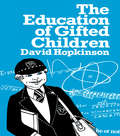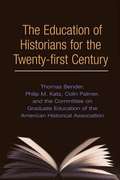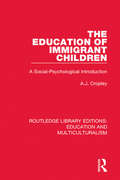- Table View
- List View
The Education Gospel: The Economic Power of Schooling
by W. Norton Grubb Marvin LazersonIn this hard-hitting history of "the gospel of education," W. Norton Grubb and Marvin Lazerson reveal the allure, and the fallacy, of the longstanding American faith that more schooling for more people is the remedy for all our social and economic problems--and that the central purpose of education is workplace preparation. But do increasing levels of education accurately represent the demands of today's jobs? Grubb and Lazerson argue that the abilities developed in schools and universities and the competencies required in work are often mismatched--since many Americans are under-educated for serious work while at least a third are over-educated for the jobs they hold. The ongoing race for personal advancement and the focus on worker preparation have squeezed out civic education and learning for its own sake. Paradoxically, the focus on schooling as a mechanism of equity has reinforced social inequality. The challenge now, the authors show, is to create environments for learning that incorporate both economic and civic goals, and to prevent the further descent of education into a preoccupation with narrow work skills and empty credentials.
The Education Industry (Routledge Library Editions: Education)
by W Kenneth RichmondIn one sense, education was always a service industry. This book examines the quality as well as the quantity of contemporary education as it answers the following questions: Are we getting value for money? What makes a good teacher? What sort of education do we want? In the UK in the twentieth century education grew while national income did not. Britain devoted more of its resources to education than any other European nation and yet the UK had the largest proportion of children leaving school at 15 and spent more on each university place than the USA. The author argues that far too little attention was paid to cost-effectiveness analysis and planning. He examines Swedish and American examples and concludes that we must seek and employ the common features of modern management – network analysis, operational research and organizational theory. He also argues that traditional education has to come to terms with the mounting pressures of new curricula and new media.
The Education Myth: How Human Capital Trumped Social Democracy (Histories of American Education)
by Jon SheltonThe Education Myth questions the idea that education represents the best, if not the only, way for Americans to access economic opportunity. As Jon Shelton shows, linking education to economic well-being was not politically inevitable. In the eighteenth and nineteenth centuries, for instance, public education was championed as a way to help citizens learn how to participate in a democracy. By the 1930s, public education, along with union rights and social security, formed an important component of a broad-based fight for social democracy.Shelton demonstrates that beginning in the 1960s, the political power of the education myth choked off powerful social democratic alternatives like A. Philip Randolph and Bayard Rustin's Freedom Budget. The nation's political center was bereft of any realistic ideas to guarantee economic security and social dignity for the majority of Americans, particularly those without college degrees. Embraced first by Democrats like Lyndon Johnson, Jimmy Carter, and Bill Clinton, Republicans like George W. Bush also pushed the education myth. The result, over the past four decades, has been the emergence of a deeply inequitable economy and a drastically divided political system.
The Education Revolution: How to Apply Brain Science to Improve Instruction and School Climate
by Horacio SanchezMaximizing student capacity and restoring motivation—the key to school success Brain research has the power to revolutionize education, but it can be difficult for educators to implement innovative strategies without the proper knowledge or resources. The Education Revolution bridges the gap between neuroscience, psychology, and educational practice. It delivers what educators need: concrete applications of the most current and relevant research that they can use in their classrooms and schools. Readers will find Teaching strategies based on the latest brain research, designed to advance academic performance Scientifically sound, solution-focused practices to address the root of negative behaviors Approaches to counteract the negative impact of technology on the brain Concrete methods to improve school climate Model lessons for teachers that demonstrate how to implement the given strategies Written by Horacio Sanchez, a leading authority on child and adolescent behavior and resiliency, this book shows educators how they can use our growing understanding of brain science to restore students’ desire to learn; improve achievement, behavior and school climate; and revolutionize education. "Sanchez combines expertise in education, psychology, and neuroscience with extensive teaching experience and extraordinary insight into what makes us all behave the way we do." Dr. David L. Katz, President, American College of Lifestyle Medicine Director, Yale University Prevention Research Center "The Education Revolution focuses on the whole child through both academic and social aspects of learning. I feel confident that I can trust this research and use these ideas in my teaching." Kendra Hanzlik, Instructional Coach Prairie Hill Elementary School, College Community School District
The Education Revolution: How to Apply Brain Science to Improve Instruction and School Climate
by Horacio SanchezMaximizing student capacity and restoring motivation—the key to school success Brain research has the power to revolutionize education, but it can be difficult for educators to implement innovative strategies without the proper knowledge or resources. The Education Revolution bridges the gap between neuroscience, psychology, and educational practice. It delivers what educators need: concrete applications of the most current and relevant research that they can use in their classrooms and schools. Readers will find Teaching strategies based on the latest brain research, designed to advance academic performance Scientifically sound, solution-focused practices to address the root of negative behaviors Approaches to counteract the negative impact of technology on the brain Concrete methods to improve school climate Model lessons for teachers that demonstrate how to implement the given strategies Written by Horacio Sanchez, a leading authority on child and adolescent behavior and resiliency, this book shows educators how they can use our growing understanding of brain science to restore students’ desire to learn; improve achievement, behavior and school climate; and revolutionize education. "Sanchez combines expertise in education, psychology, and neuroscience with extensive teaching experience and extraordinary insight into what makes us all behave the way we do." Dr. David L. Katz, President, American College of Lifestyle Medicine Director, Yale University Prevention Research Center "The Education Revolution focuses on the whole child through both academic and social aspects of learning. I feel confident that I can trust this research and use these ideas in my teaching." Kendra Hanzlik, Instructional Coach Prairie Hill Elementary School, College Community School District
The Education System in Malawi: Country Status Report
by World Bank'The Education System in Malawi', an Education Country Status Report (CSR), is a detailed analysis of the current status of the education sector in Malawi, the results of which have been validated by the government of Malawi. Its main purpose is to enable decision makers to orient national policy on the basis of a factual diagnosis of the overall education sector and to provide relevant analytical information for the dialogue between the government and development partners. The analysis incorporates data and information from multiple sources, such as school administrative surveys by the Ministry of Education, household surveys, and a tracer survey created especially for this study. This CSR, developed by a multi-ministerial national team supported by UNESCO Pôle de Dakar, the World Bank, and GTZ specialists, updates the previous one drawn up in 2003 and consists of eight chapters, including a chapter on higher education. The analysis provides key monitoring and evaluation inputs for the overall education sector, particularly under the framework of the implementation of the National Education Sector Plan.
The Education System in Swaziland: Training and Skills Development for Shared Growth and Competitiveness
by World BankPolicy makers recognize that developing capacity for knowledge and technology driven growth is necessary for Swaziland to integrate into the global economy and to be competitive; in particular because Swaziland is not rich in exploitable natural resources. The Education Training and Skills Development Sector (ETSDS), the educational sector of Swaziland's long-term development and reform program, covers all levels of education, from early childhood to post-secondary education. This paper evaluates the adequacy of the ETSDS in light of the enhanced educational goal for the country. Acknowledging that financing reforms will be a challenge, this paper makes recommendations to enhance the program's effectiveness, such as expanding access, strengthening delivery modes, and minimizing financial barriers to education and training.
The Education Systems of Europe
by Wolfgang Hörner Hans Döbert Lutz R. Reuter Botho KoppThis updated second edition presents an analytical description of the education systems of all European countries, following common guidelines. These conceptual guidelines consider various criteria concerning presumptions as to the quality of a good education system. One of the book central aims is to explore the paradoxical character of education, i. e. the relationship between universal values and the search for a national identity. The common structure of the different country analyses oriented by crucial problems of education worldwide guides to discover common patterns of European education compared to that of education systems outside Europe, making its reading relevant to educators around the world. The handbook provides many suggestions for further study.
The Education Systems of the Americas (Global Education Systems)
by Marcelo Parreira do Amaral Sieglinde JornitzThis handbook focuses on the education systems in the three Americas, North, Central and South America, and includes a chapter on most countries in the region. The chapters follow a common structure and include information on the development, organization, and current trends in mainstream education from pre-primary to tertiary level for each country. Chapter contributions are organized along three parts: Each chapter starts with a description of the historical and social foundations of the education system from their founding period up to today, including discussions of political, economic and cultural contexts and conditions. This first part closes with a description of how transitions from education to the labor market are organized. The second part consists of an overview of the institutional and organizational principles as well as of the structure of education from pre-primary to tertiary level. It includes a focus on legislative bases and financial provisions for the education system and a description of the structure by using the ISCED-classification. It further includes information of the supply of human resources such as teachers and other educators. The third and final part of the chapters discusses selected educational trends and aspects of particular interest: dealing with inequality, ICT and digitization activities, and STEM-related policies and programs.The Handbook delivers a fundamental description of the educational systems, including information about how they were shaped, how they are organized and respectively cared for by national stakeholders. It provides both to students and scholars who seek concise and systematic knowledge about education in a particular country. Also, comparative researchers will find a basis for better understanding of various educational questions about the foundations and development of the national education systems.
The Education Trap: Schools and the Remaking of Inequality in Boston
by Cristina Viviana GroegerWhy—contrary to much expert and popular opinion—more education may not be the answer to skyrocketing inequality. For generations, Americans have looked to education as the solution to economic disadvantage. Yet, although more people are earning degrees, the gap between rich and poor is widening. Cristina Groeger delves into the history of this seeming contradiction, explaining how education came to be seen as a panacea even as it paved the way for deepening inequality. The Education Trap returns to the first decades of the twentieth century, when Americans were grappling with the unprecedented inequities of the Gilded Age. Groeger’s test case is the city of Boston, which spent heavily on public schools. She examines how workplaces came to depend on an army of white-collar staff, largely women and second-generation immigrants, trained in secondary schools. But Groeger finds that the shift to more educated labor had negative consequences—both intended and unintended—for many workers. Employers supported training in schools in order to undermine the influence of craft unions, and so shift workplace power toward management. And advanced educational credentials became a means of controlling access to high-paying professional and business jobs, concentrating power and wealth. Formal education thus became a central force in maintaining inequality. The idea that more education should be the primary means of reducing inequality may be appealing to politicians and voters, but Groeger warns that it may be a dangerous policy trap. If we want a more equitable society, we should not just prescribe more time in the classroom, but fight for justice in the workplace.
The Education We Need for a Future We Can′t Predict
by Thomas C. Hatch Jordan Corson Sarah Gerth van den BergImprove Schools and Transform Education In order for educational systems to change, we must reevaluate deep-seated beliefs about learning, teaching, schooling, and race that perpetuate inequitable opportunities and outcomes. Hatch, Corson, and Gerth van den Berg challenge the narrative when it comes to the "grammar of schooling"--or the conventional structures, practices, and beliefs that define educational experiences for so many children—to cast a new vision of what school could be. The book addresses current systemic problems and solutions as it: Highlights global examples of successful school change Describes strategies that improve educational opportunities and performance Explores promising approaches in developing new learning opportunities Outlines conditions for supporting wide-scale educational improvement This provocative book approaches education reform by highlighting what works, while also demonstrating what can be accomplished if we redefine conventional schools. We can make the schools we have more efficient, more effective, and more equitable, all while creating powerful opportunities to support all aspects of students’ development. "You won’t find a better book on system change in education than this one. We learn why schools don’t change; how they can improve; what it takes to change a system; and, in the final analysis, the possibilities of system change. Above all, The Education We Need renders complexity into clarity as the writing is so clear and compelling. A powerful read on a topic of utmost importance." ~Michael Fullan, Professor Emeritus, OISE/Universtiy of Toronto "I cannot recommend this book highly enough – Tom tackles long-standing and emerging educational issues in new ways with an impressive understanding of the challenging complexities, but also feasible possibilities, for ensuring excellence and equity for all students." ~Carol Campbell, Associate Professor, Ontario Institute for Studies in Education, University of Toronto
The Education We Need for a Future We Can′t Predict
by Thomas C. Hatch Jordan Corson Sarah Gerth van den BergImprove Schools and Transform Education In order for educational systems to change, we must reevaluate deep-seated beliefs about learning, teaching, schooling, and race that perpetuate inequitable opportunities and outcomes. Hatch, Corson, and Gerth van den Berg challenge the narrative when it comes to the "grammar of schooling"--or the conventional structures, practices, and beliefs that define educational experiences for so many children—to cast a new vision of what school could be. The book addresses current systemic problems and solutions as it: Highlights global examples of successful school change Describes strategies that improve educational opportunities and performance Explores promising approaches in developing new learning opportunities Outlines conditions for supporting wide-scale educational improvement This provocative book approaches education reform by highlighting what works, while also demonstrating what can be accomplished if we redefine conventional schools. We can make the schools we have more efficient, more effective, and more equitable, all while creating powerful opportunities to support all aspects of students’ development. "You won’t find a better book on system change in education than this one. We learn why schools don’t change; how they can improve; what it takes to change a system; and, in the final analysis, the possibilities of system change. Above all, The Education We Need renders complexity into clarity as the writing is so clear and compelling. A powerful read on a topic of utmost importance." ~Michael Fullan, Professor Emeritus, OISE/Universtiy of Toronto "I cannot recommend this book highly enough – Tom tackles long-standing and emerging educational issues in new ways with an impressive understanding of the challenging complexities, but also feasible possibilities, for ensuring excellence and equity for all students." ~Carol Campbell, Associate Professor, Ontario Institute for Studies in Education, University of Toronto
The Education and Care of Children with Severe, Profound and Multiple Learning Disabilities: Musical Activities to Develop Basic Skills
by Richard AirdThis is a practical guide to managing the whole curriculum for children with severe learning difficulties (SLD). Crucial guidance and effective strategies are provided on how to reconcile the rights, needs and aspirations of such children in light of recent national trends and QCA guidelines.
The Education and Training of the Mentally Retarded: Recent Advances (Routledge Library Editions: Special Educational Needs #1)
by Adrian F. Ashman, Ronald S. LauraFirst published in 1985. The field of mental handicap is a broad one encompassing the interests of many professional groups. As a result, there is a need periodically to present wide-ranging reviews of advances in the field. This is the central aim of this volume. Two chapters focus on the cognitive domain, and are especially pertinent in view of the recent release of the new Kaufman Assessment Battery for Children which uses Das’s theoretical position as its foundation. Another contribution reviews the area of non-speech communication with those with special needs, a subject of much current interest and controversy. Other chapters focus on major issues such as maladaptive behaviour and deinstitionalization and use of new technology. The book is thus likely to be relevant to all those with an interest in advances in mental handicap research.
The Education of Arabic Speaking Refugee Children and Young Adults: Education, Employment and Social Inclusion
by Nina Maadad I Gusti DarmawanSustained political and socioeconomic crises can potentially deprive generations of young people and adults of their economic and employment prospects, stability, mental health and freedom. The Education of Arabic Speaking Refugee Children and Young Adults provides a comprehensive overview of the situation of Arabic-speaking refugee children and their psychosocial, schooling and employment experiences in three case countries: Australia, Italy and Indonesia. The book considers what education arrangements were put in place for refugee children, how were they supported in schools for physical and psychological needs, how the school environment hindered or assisted their learning experience and the way in which these students were affected by the global COVID-19 pandemic. The authors provide recommendations for educational practices and employment pathways as informed by the refugee children and young adults themselves, teachers, parents, schools and state officials. This book will be of great interest to academics, researchers and post-graduate students in the fields of comparative education and refugee and migrant education. It will also be beneficial for educators, teachers and policy-makers.
The Education of Catholic Americans
by Andrew M. GreeleyFirst Published in 2017. Routledge is an imprint of Taylor & Francis, an Informa company.
The Education of Children Engaged in Industry in England 1833-1876 (Routledge Revivals)
by Adam Henry RobsonOriginally published in 1931, this title looks at the education received by children working in industry in England between 1833 and 1876. The industrial revolution created more demand for child labour than ever before, but there were few laws to protect the children involved. School was not compulsory for children until the 1880s, but there were new laws brought in and enforced to reduce the numbers of hours they were allowed to work in industry in 1833 and subsequently in 1844. This title deals with the education of children during that time and the implications of the laws introduced.
The Education of Children Under Seven (Routledge Library Editions: Education)
by Mary SturtThis book does not cover the whole field of Infants’ Teaching but is concerned mainly with general principles and matters which are open to the non-specialist. Some technical subjects such as Physical Education have been omitted but nonetheless the volume provides a thorough (if somewhat dated) introduction to early years education in the first half of the twentieth century.
The Education of Children with Severe Learning Difficulties: Bridging the Gap between Theory and Practice (Routledge Library Editions: Special Educational Needs #11)
by Judith Coupe and Jill PorterFirst published in 1986. Aimed at teachers, students and related professions this book serves to bridge the gap between the theory and practice of educating pupils with severe learning difficulties. In the light of the 1981 Education Act it is crucial to identify, and subsequently meet, the needs of these pupils. This can only be done by an in-depth understanding of curriculum design, child development and the learning process. This book incorporates these aspects together with an appreciation of teaching techniques and school and classroom organisation. It explains how the parents, school staff and linked agencies complement this procedure.
The Education of Children: Individual Psychology In The Schools And The Education Of Children: Education For Prevention (Psychology Revivals)
by Alfred AdlerOriginally published in 1930, this title looks at the education of children. Adler believes the problems from a psychological point of view are the same as for adults, that of self-knowledge and rational self-direction. However, the difference being that due to the ‘immaturity of children, the question of guidance – never wholly absent in the case of adults – takes on supreme importance.’ The title starts by presenting the Individual Psychology viewpoint as a whole, with the later chapters undertaking to tackle in more depth the various interrelated problems of children’s education.
The Education of Dual Sensory Impaired Children: Recognising and Developing Ability (Routledge Library Editions: Special Educational Needs #17)
by David EtheridgeThis book, originally published in 1995, is about ability, not disability. It is about what children can do and how they can progress. All children have the moral, ethical and legal right to be educated, no matter what barriers society puts in their way because of their physical disabilities. Dual sensory impaired children, like all others, have the right under the Education Reform Act, 1988, to a broadly-based and balanced curriculum that is appropriate to their needs since they, like any children, will not develop educationally unless that curriculum is appropriate to their needs. This book aims to show some of the ways in which individual children can demonstrate and develop their individual abilities.
The Education of Eros: A History of Education and the Problem of Adolescent Sexuality (Studies in Curriculum Theory Series)
by Dennis L. CarlsonThe Education of Eros is the first and only comprehensive history of sexuality education and the “problem” of adolescent sexuality from the mid-20th century to the beginning of the 21st. It explores how professional health educators, policy makers, and social and religious conservatives differed in their approaches, and battled over what gets taught about sexuality in schools, but all shared a common understanding of the adolescent body and adolescent desire as a problem that required a regulatory and disciplinary education. It also looks the rise of new social movements in civil society and the academy in the last half of the 20th century that began to re-frame the “problem” of adolescent sexuality in a language of rights, equity, and social justice. Situated within critical social theories of sexuality, this book offers a tool for re-framing the conversation about adolescent sexuality and reconstructing the meaning of sexuality education in a democratic society.
The Education of Gifted Children
by David HopkinsonFirst Published in 1978. Routledge is an imprint of Taylor & Francis, an informa company.
The Education of Historians for Twenty-first Century
by Thomas Bender Colin A. Palmer Philip F. KatzIn 1958, the American Historical Association began a study to determine the status and condition of history education in U.S. colleges and universities. Published in 1962 and addressing such issues as the supply and demand for teachers, student recruitment, and training for advanced degrees, that report set a lasting benchmark against which to judge the study of history thereafter. Now, more than forty years later, the AHA has commissioned a new report. The Education of Historians for the Twenty-first Century documents this important new study's remarkable conclusions. Both the American academy and the study of history have been dramatically transformed since the original study, but doctoral programs in history have barely changed. This report from the AHA explains why and offers concrete, practical recommendations for improving the state of graduate education. The Education of Historians for the Twenty-first Century stands as the first investigation of graduate training for historians in more than four decades and the best available study of doctoral education in any major academic discipline. Prepared for the AHA by the Committee on Graduate Education, the report represents the combined efforts of a cross-section of the entire historical profession. It draws upon a detailed review of the existing studies and data on graduate education and builds upon this foundation with an exhaustive survey of history doctoral programs. This included actual visits to history departments across the country and consultations with scores of individual historians, graduate students, deans, academic and non-academic employers of historians, as well as other stakeholders in graduate education. As the ethnic and gender composition of both graduate students and faculty has changed, methodologies have been refined and the domains of historical inquiry expanded. By addressing these revolutionary intellectual and demographic changes in the historical profession, The Education of Historians for the Twenty-first Century breaks important new ground. Combining a detailed historical snapshot of the profession with a rigorous analysis of these intellectual changes, this volume is ideally positioned as the definitive guide to strategic planning for history departments. It includes practical recommendations for handling institutional challenges as well as advice for everyone involved in the advanced training of historians, from department chairs to their students, and from university administrators to the AHA itself. Although focused on history, there are lessons here for any department. The Education of Historians for the Twenty-first Century is a model for in-depth analysis of doctoral education, with recommendations and analyses that have implications for the entire academy. This volume is required reading for historians, graduate students, university administrators, or anyone interested in the future of higher education.
The Education of Immigrant Children: A Social-Psychological Introduction (Routledge Library Editions: Education and Multiculturalism #3)
by A. J. CropleyOriginally published in 1983. This book concentrates on the psychological factors within immigrants and on the importance of these for relations with locals and for education. It argues that immigrants experience a state of estrangement from both their own societies and from the receiving society. The educational effects of this manifest themselves partly in poor achievement, partly in poor behaviour and in dropping out of society. These are seen as the results of a diminished self-worth, a feeling of being pre-programmed to failure, and of being outsiders. This study develops a psychological model of the state of affairs and of the desirable educational measures needed for coping with it – in educational planning, curriculum development, teacher training and so on. It presents guidelines or suggestions for areas and kinds of actions, not presentating specific materials or programmes. This book fosters development of insight and understanding among teachers, policy-makers, teacher trainers and immigrants themselves.

